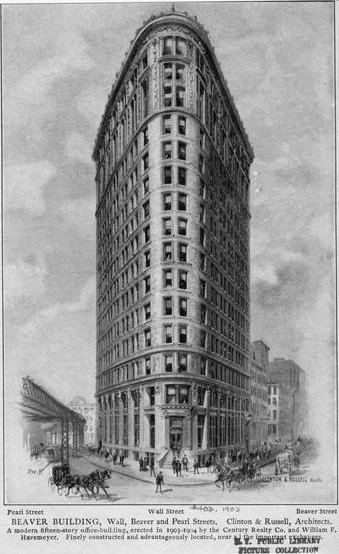Clinton and Russell was a well-known architecture firm founded in 1894 in New York City, United States. The firm was responsible for scores of notable New York City buildings, downtown and throughout the city.
Charles W. Clinton (1838–1910) was born and raised in New York and received his formal architectural training in the office of Richard Upjohn. He left Upjohn in 1858 to begin a private practice, and from then through 1894 he conducted his own significant career, the highpoint of which was probably the 1880 Seventh Regiment Armory.
William Hamilton Russell (1856–1907) was born in New York City as well. He attended the Columbia School of Mines before he joined his great uncle, James Renwick, in his architecture firm in 1878. At Columbia, Russell had been a member of St. Anthony Hall, the secret fraternal college society, and within a year of his joining his great uncle's firm, in 1879, Renwick completed the first St. A's Chapter House, at 25 East 28th Street, likely with Russell involved in the design work. [2]
In New York City's ambitious building boom circa 1900, Clinton and Russell were responsible for designing the world's largest apartment building, the world's largest office building, and a cluster of early downtown skyscrapers along Broadway and Wall Street for banks and insurance companies. Many of the firm's important commissions related to real estate investments of the Astor family. The landmark Astor Hotel that served as an anchor for the development of Times Square, the Astor Apartments, the Graham Court Apartments, and The Apthorp were among their projects for William Waldorf Astor, 1st Viscount Astor. Stylistically, much of their work conformed to a conservative Italian Neo-Renaissance style.
After the deaths of the principals the firm continued in business, and in 1926 it was renamed Clinton Russell Wells Holton & George (and variations of that name). For a time the English-born Colonel James Hollis Wells (1864-1926) headed the organization; the Lillian Sefton Dodge Estate on Long Island is his design. The firm remained in existence until 1940.
for Clinton's independent commissions prior to 1894, see Charles W. ClintonFahys Building, 52-54 Maiden Lane, 1894-96 (razed)Sampson Building, 63-65 Wall Street, 1898 (razed)Hudson Building, 32-34 Broadway, 1896–98Exchange Court Building, 52-56 Broadway, 1896-98 (altered, now the Exchange Apartments) Woodbridge Building, William and Platt Streets, NYC, 1898 (razed in 1970)Curzon House, facade redesign of #4 East 62nd Street, NYC, 1898the Franklin Building, 9-15 Murray Street, 1898the Chesebrough Building, 13-19 State Street, Battery Park, NYC, 1899 (razed) Graham Court Apartments, 1899-1901Medbery Hall, Dorm Building for Hobart College, 1900Broad Exchange Building, #25 Broad Street, New York City, 1900Coxe Hall, Administrative and Classroom Building for Hobart College, 1901American Exchange National Bank Building 128 Broadway, 1901 (razed)the 18-story Atlantic Building, aka the Mutual Insurance Building, Wall and William Streets, 1901Astor Apartments, 1901-1905Wall Street Exchange Building, 43-49 Exchange Place, 1903Beaver Building, 1904Hotel Astor, New York City, 1904, expanded 1909-1910 (razed 1967)71st Infantry Regiment Armory, Park Avenue and 34th Street, NYC, 1905 (razed 1976)The Langham Apartments, one of the towering apartment buildings lining Central Park West between West 73rd and West 74th Streets, 1905-1907U.S. Express Company Building, 2 Rector Street, 1905–07The Apthorp Apartments, briefly the largest apartment building in the world, NYC, 1906-1908Consolidated Stock Exchange Building, 61-69 Broad Street, 1907 (razed)Lawyers' Title Insurance & Trust Company, 160 Broadway, NYC, 1908the 31-story Whitehall Building Annex, 1908-1910the Hudson Terminal in lower Manhattan, the world's largest office building by floor area when built in 1908, razed in 1962 for the World Trade CenterWhyte's Restaurant, Fulton Street, designed as a "half-timbered English village inn", 1910redesign of Clarence True's 103-104 Riverside Drive, 1910-1911Otis Elevator Building, 260 Eleventh Avenue, 1911-1912East River Savings Bank Building, NW corner of Broadway and Reade Streets, 1911portions of the Elks National Home, Bedford, Virginia, 1916Mecca Masonic Temple (1923) in collaboration with the architect Harry P. Knowles, now known as New York City CenterLillian Sefton Dodge Estate, Mill Neck, Nassau County, New York, 1923The Level Club, New York City, 1927Cities Service Building, now called the American International Building, 19327 East 67th Street facade.
